South Korea, Russia point fingers
War of words
https://www.cnn.com/2019/07/23/asia/south-korea-russia-military-intl-hnk/index.html
2019-07-23 09:04:00Z
52780337956008







SEOUL, South Korea — South Korea said its air force jets fired hundreds of warning shots on Tuesday to ward off a Russian military plane that intruded upon its territorial airspace, the first such encounter between the countries in decades.
The Russian and Chinese aerial incursions into sensitive airspace between South Korea and Japan — two key American allies — was a daring challenge to Washington and Seoul.
Three Russian military planes, as well as two Chinese warplanes, on Tuesday entered South Korea’s air defense identification zone off its east coast, where foreign military aircraft must identify themselves in advance to South Korea, the South’s military said.
But one of the Russian planes, a Beriev A-50 early warning and control aircraft, flew closer to South Korea, intruding twice into its territorial airspace near Dokdo, a cluster of South Korean-held islets that are also claimed by Japan, the South Korean military said.
Both times, the Russian plane violated South Korea’s airspace for a few minutes, prompting South Korean F-15 and F-16 fighter jets operating nearby to fire 20 flares and 360 machine gun rounds as warning shots from a half mile away, the officials said. The South Korean jets took the action after the Russian plane did not answer repeated radio warnings.
The South Korean military provided no further details. But its officials said that it was highly unusual for Russian and Chinese planes to stage a joint flight mission over the sea between South Korea and Japan.
In recent years, long-range bombers and reconnaissance planes from the Russian and Chinese militaries have frequently entered South Korea’s air defense identification zone, prompting its air force to dispatch fighter jets to confront them.
But the episodes on Tuesday marked the first time in recent memory that a Russian warplane entered South Korea’s territorial airspace without approval, South Korean officials said.
Chung Eui-yong, the national security adviser for President Moon Jae-in of South Korea, sent a warning to his Russian counterpart, Nikolai Patrushev, secretary of Russia’s Security Council, Mr. Moon’s office said on Tuesday. It warned that South Korea would take “a far stronger action” if Russia tried similar maneuvers.
Seoul also planned to summon Russian and Chinese diplomats in South Korea to lodge a protest, officials said. And the Japanese government lodged a formal complaint against both the Russian maneuvers and South Korean machine gun barrage over “our territory,” the Kyodo News agency reported.
There was no immediate reaction from Moscow or Beijing.
Military planes that enter another country’s air defense identification zone must notify that country in advance, but in recent years countries in the region have often accused each other of violating that protocol. If a military plane enters the zone without proper notice, the host country may order it to leave, or dispatch military jets to confront the intruding aircraft.
In 2013, South Korea expanded its air defense identification zone for the first time in 62 years to include airspace over the East China Sea that is also claimed by China and Japan. With South Korea’s expansion, the air defense zones of all three countries now overlap over a submerged reef called Ieodo in South Korea and Suyan Rock in China.
South Korea expanded its air patrol zone two weeks after China stoked regional tensions by unilaterally expanding its own air patrol zone to include airspace over the reef. The expanded Chinese air control zone also covers a set of East China Sea islands, called Diaoyu in Chinese and Senkaku in Japanese, which are at the heart of a territorial feud between Japan and China.
The overlapping zones have raised the risk of military tensions in the region.



Dozens of people were injured at a subway station in Hong Kong on Sunday when a mob of masked assailants attacked protesters and passengers in a dramatic escalation of violence amid ongoing protests in the Chinese territory.
The sudden assault came after police fired tear gas at those who failed to disband after a massive march by demonstrators still fighting a proposed extradition bill and calling for electoral reforms in Hong Kong.
Dozens of men stormed the Yuen Long MTR station around midnight, forcing open closed entrances before hurling objects and assaulting protesters, in addition to passengers, at the subway station.
HONG KONG MARCHERS PELT BEIJING LIAISON OFFICE WITH EGGS IN LATEST PROTEST
Hong Kong media released video showing masked assailants attacking commuters -- and protesters clad in their trademark black clothing and yellow hard hats -- in a subway station.
The attackers, meanwhile, were dressed in white and had black masks pulled over their heads. On Saturday, demonstrators had worn white at a counter-rally in support of police.
Footage from Apple Daily showed some of the attackers using umbrellas to beat people in the station and inside a subway car.
The South China Morning Post reported some people tried to fight back by hurling their helmets, and the Hospital Authority told the news outlet at least 45 people had been sent to nearby hospitals after the attacks.
Subway passengers, including one lawmaker, castigated police officers for allegedly failing to intervene.
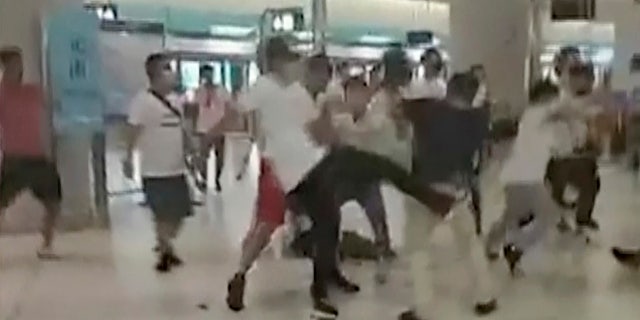
This Sunday, July 21, 2019, image taken from a video, shows confrontation between masked assailants and protesters at Yuen Long MTR train station in Hong Kong. (Lam Cheuk-ting via AP)
Democratic lawmaker Lam Cheuk-ting told Reuters the men appeared to target black-shirted passengers who had been at an anti-government march. Lam, who was wounded in the face and hospitalized, told the news agency police officers on the scene ignored his pleas to step in and help stop the attacks.
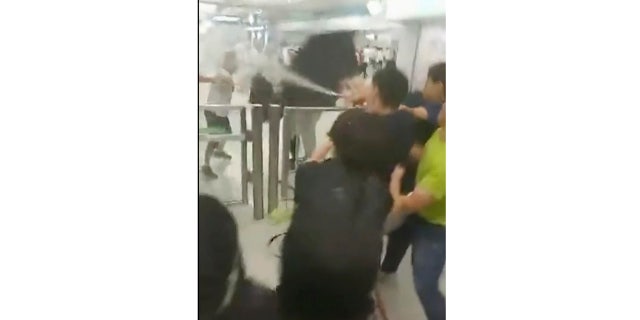
Protesters trying to return home in Hong Kong were attacked inside a train station by assailants who appeared to target the pro-democracy demonstrators. (Lam Cheuk-ting via AP)
“They deliberately turned a blind eye to these attacks by triads on regular citizens,” he told Reuters, saying the floors of the station were streaked with blood. “I won’t speculate on why they didn’t help immediately."
CLASHES ERUPT AS THOUSANDS MARCH IN HONG KONG AGAINST CHINESE TRADERS
The Hong Kong government said in a statement shortly after midnight that commuters were attacked at a subway station in the city's Yuen Long neighborhood, leading to "confrontations and injuries." The statement also said some "radical protesters initiated a series of violent acts...despite repeated warnings" by police. They said the acts included hurling petrol bombs, setting fires and throwing bricks.
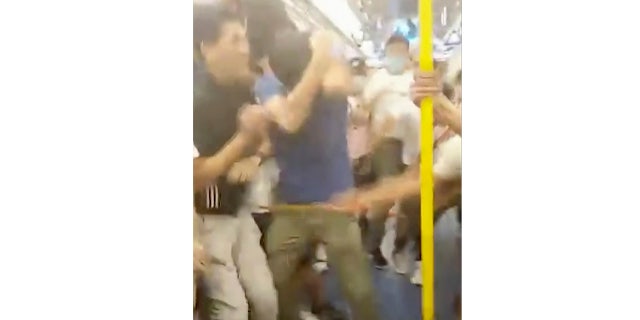
This Sunday, July 21, 2019, image made from a video, shows fighting inside a train car in Hong Kong. Protesters trying to return home were attacked inside a train station by assailants who appeared to target the pro-democracy demonstrators. (Lam Cheuk-ting via AP)
"This is absolutely unacceptable to Hong Kong as a society that observes the rule of law," the statement said, referring to the acts of the subway attackers -- as well as the protesters.
Embattled Hong Kong Chief Executive Carrie Lam condemned the "shocking" violence, adding police will fully investigate the incident.
“Violence is not a solution to any problem. Violence will only breed more violence,” Lam said. “We absolutely do not tolerate such violence.”
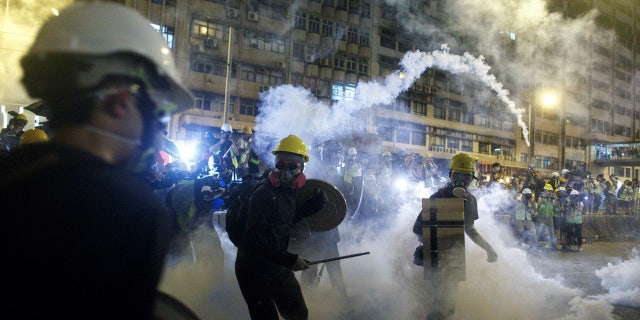
Protesters react to tear gas during a confrontation with riot police in Hong Kong Sunday, July 21, 2019. (Eric Tsang/HK01 via AP)
Lam has declared the contentious extradition bill dead, but protesters are dissatisfied with her refusal to formally withdraw the legislation. Some are also calling for her to resign amid growing concerns about the steady erosion of civil rights in the city.
CLICK HERE FOR THE FOX NEWS APP
The march on Sunday had been peaceful when it reached its police-designated endpoint in Hong Kong's Wan Chai district in the late afternoon, but thousands continued onward, at various points occupying key government and business districts. Organizers said 430,000 people participated in Sunday's march, while police said there were 138,000 during the procession's "peak period."
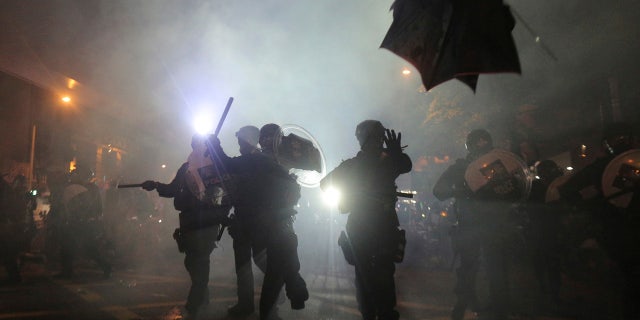
Hong Kong police launched tear gas at protesters Sunday after a massive pro-democracy march continued late into the evening. (Andy Lo/HK01 via AP)
The group then headed for the Liaison Office, which represents China's Communist Party-led central government within the city, where some protesters threw eggs at the building and spray-painted its surrounding surveillance cameras. China's national emblem, which adorns the front of the Liaison Office, was splattered with black ink. The Liaison Office said in comments published on Chinese state media that the acts "openly challenged the authority of the central government and touched the bottom line of the 'one country, two systems' principle."

A protestor kicks a tear gas canister during confrontation in Hong Kong Sunday, July 21, 2019. (Ming Ko/HK01 via AP)
Hong Kong, a former British colony, was handed back to China in 1997 and was promised certain democratic freedoms under the framework of "one country, two systems." Fueled by anger at Lam and an enduring distrust of the Communist Party-ruled central government in Beijing, the current demonstrations have ballooned into calls for electoral reform and an investigation into alleged police brutality at the protests.
The Associated Press contributed to this report.
Dozens of people were injured at a subway station in Hong Kong on Sunday when a mob of masked assailants attacked protesters and passengers in a dramatic escalation of violence amid ongoing protests in the Chinese territory.
The sudden assault came after police fired tear gas at those who failed to disband after a massive march by demonstrators still fighting a proposed extradition bill and calling for electoral reforms in Hong Kong.
Dozens of men stormed the Yuen Long MTR station around midnight, forcing open closed entrances before hurling objects and assaulting protesters, in addition to passengers, at the subway station.
HONG KONG MARCHERS PELT BEIJING LIAISON OFFICE WITH EGGS IN LATEST PROTEST
Hong Kong media released video showing masked assailants attacking commuters -- and protesters clad in their trademark black clothing and yellow hard hats -- in a subway station.
The attackers, meanwhile, were dressed in white and had black masks pulled over their heads. On Saturday, demonstrators had worn white at a counter-rally in support of police.
Footage from Apple Daily showed some of the attackers using umbrellas to beat people in the station and inside a subway car.
The South China Morning Post reported some people tried to fight back by hurling their helmets, and the Hospital Authority told the news outlet at least 45 people had been sent to nearby hospitals after the attacks.
Subway passengers, including one lawmaker, castigated police officers for allegedly failing to intervene.

This Sunday, July 21, 2019, image taken from a video, shows confrontation between masked assailants and protesters at Yuen Long MTR train station in Hong Kong. (Lam Cheuk-ting via AP)
Democratic lawmaker Lam Cheuk-ting told Reuters the men appeared to target black-shirted passengers who had been at an anti-government march. Lam, who was wounded in the face and hospitalized, told the news agency police officers on the scene ignored his pleas to step in and help stop the attacks.

Protesters trying to return home in Hong Kong were attacked inside a train station by assailants who appeared to target the pro-democracy demonstrators. (Lam Cheuk-ting via AP)
“They deliberately turned a blind eye to these attacks by triads on regular citizens,” he told Reuters, saying the floors of the station were streaked with blood. “I won’t speculate on why they didn’t help immediately."
CLASHES ERUPT AS THOUSANDS MARCH IN HONG KONG AGAINST CHINESE TRADERS
The Hong Kong government said in a statement shortly after midnight that commuters were attacked at a subway station in the city's Yuen Long neighborhood, leading to "confrontations and injuries." The statement also said some "radical protesters initiated a series of violent acts...despite repeated warnings" by police. They said the acts included hurling petrol bombs, setting fires and throwing bricks.

This Sunday, July 21, 2019, image made from a video, shows fighting inside a train car in Hong Kong. Protesters trying to return home were attacked inside a train station by assailants who appeared to target the pro-democracy demonstrators. (Lam Cheuk-ting via AP)
"This is absolutely unacceptable to Hong Kong as a society that observes the rule of law," the statement said, referring to the acts of the subway attackers -- as well as the protesters.
Embattled Hong Kong Chief Executive Carrie Lam condemned the "shocking" violence, adding police will fully investigate the incident.
“Violence is not a solution to any problem. Violence will only breed more violence,” Lam said. “We absolutely do not tolerate such violence.”

Protesters react to tear gas during a confrontation with riot police in Hong Kong Sunday, July 21, 2019. (Eric Tsang/HK01 via AP)
Lam has declared the contentious extradition bill dead, but protesters are dissatisfied with her refusal to formally withdraw the legislation. Some are also calling for her to resign amid growing concerns about the steady erosion of civil rights in the city.
CLICK HERE FOR THE FOX NEWS APP
The march on Sunday had been peaceful when it reached its police-designated endpoint in Hong Kong's Wan Chai district in the late afternoon, but thousands continued onward, at various points occupying key government and business districts. Organizers said 430,000 people participated in Sunday's march, while police said there were 138,000 during the procession's "peak period."

Hong Kong police launched tear gas at protesters Sunday after a massive pro-democracy march continued late into the evening. (Andy Lo/HK01 via AP)
The group then headed for the Liaison Office, which represents China's Communist Party-led central government within the city, where some protesters threw eggs at the building and spray-painted its surrounding surveillance cameras. China's national emblem, which adorns the front of the Liaison Office, was splattered with black ink. The Liaison Office said in comments published on Chinese state media that the acts "openly challenged the authority of the central government and touched the bottom line of the 'one country, two systems' principle."

A protestor kicks a tear gas canister during confrontation in Hong Kong Sunday, July 21, 2019. (Ming Ko/HK01 via AP)
Hong Kong, a former British colony, was handed back to China in 1997 and was promised certain democratic freedoms under the framework of "one country, two systems." Fueled by anger at Lam and an enduring distrust of the Communist Party-ruled central government in Beijing, the current demonstrations have ballooned into calls for electoral reform and an investigation into alleged police brutality at the protests.
The Associated Press contributed to this report.
John Bacon USA TODAY
Published 9:10 AM EDT Jul 22, 2019
Days after the U.S. celebrated the 50th anniversary of the first human steps on the moon, India on Monday launched an unmanned flight bound for the far side of the moon.
If Chandrayaan2's lander Vikram successfully touches down as scheduled on Sept. 7, India will join the U.S., Russia and China as nations to successfully land on the moon. India hopes to complete a manned mission to the moon within three years.
Indian Space Research Organization's mission control center in the southern city of Sriharikota burst into applause after the launch.
"It is the beginning of a historical journey of India toward the moon," said K Sivan, head of the agency. "It is my duty to salute all the people who have done the work."
The launch helped wash away the disappointment felt across the nation just one week ago, when the launch was scrubbed less than an hour before ignition because of a "technical snag," according to the space agency.
Indian media later reported that a helium leak was to blame.
On Monday, Indian Prime Minister Narendra Modi reflected the nation's ride on Twitter in a series of tweets.
"Indian at heart, Indian in spirit!" he tweeted. "Efforts such as #Chandrayaan2 will further encourage our bright youngsters towards science, top quality research and innovation."
U.S. flights took just a few days to arrive at the moon. In order to save fuel, India is using a circuitous route relying on the slingshot effect of the Earth's gravity. For more than three weeks, Chandrayaan – which translates to mooncraft in Sanskrit, an ancient Indian language – will first orbit the Earth before making its way to a lunar orbit.
The lander Vikram will separate from the orbiter and perform a series of complex maneuvers aimed at slowing its approach. Imaging of the landing area will be used to find a "hazard-free zone" for a soft landing in a high plain between two craters, the space agency said.
The lander's 14-day mission focus on the search for water and minerals and will attempt to measure moonquakes.
India's first lunar mission, more than a decade ago with Chandrayaan1, did not land on the moon but conducted a search for water using radar.
Contributing: The Associated Press